In a text translated from Pliny the Elder, he defines garum as “a choice liquor consisting of the guts of fish and the other parts that would otherwise be considered refuse.”
Mmm. That sounds good. I’ll have that.
If ever you’ve sought a game about craft brewing endless vats of fermented fish sauce, look no further than Garum, designed by Ricardo Jorge Gomes. This culinary tile-laying puzzle from Portuguese publisher Pythagoras looks back to the brine tanks of ancient Rome. May the finest condiment win!
Hunger Games: Troia
In Garum, players take turns laying tiles into a grid of sixteen cetarium (fishponds/vats) on the front side of the board, labeled Troia. There are four player colors in the game, and each vat will receive one tile from each player color in every round regardless of the player count. In the two-player game, each human controls two colors, alternating placement between turns. In the three-player game, the first player places the neutral color at the end of each round.
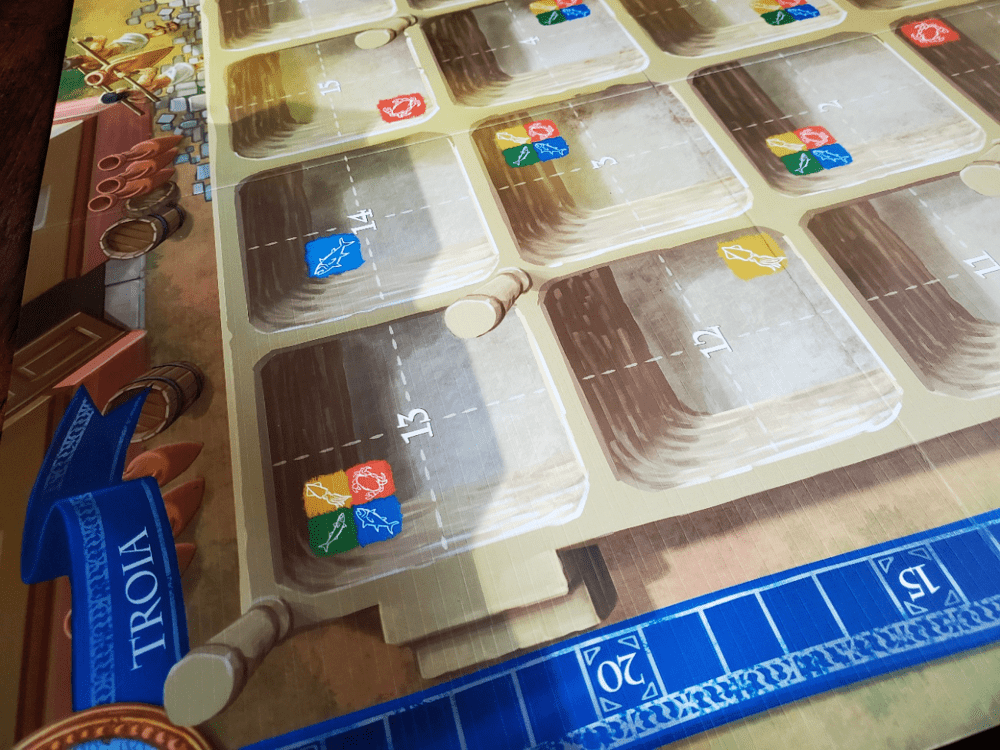
Scoring is generated not by the tiles alone, but in combination with the workers placed around the outside of the condiment arena. If you’ll allow me a bit of math confusion to set the stage: here we have a 4×4 grid of vats. Each vat contains four tiles arranged 2×2. Each tile contains fish icons oriented 2×2, meaning the finished grid will contain 16×16 fish icons. Two sides of the board each hold 16 worker spaces to claim rows and columns. Whew! We made it.
The aim in Garum is to lay tiles creating rows and columns filled with your player color. At the outset of each round, one aureus coin is flipped, revealing the vat into which players must lay tiles from their hand of four. On each turn, in addition to placing one tile, players may place one of their six worker meeples indicating control of a particular row or column. There are five teeny meeples and a singular, double-scoring grande meeple. At the end of the game, players count the number of fish aligned with each of their meeples to determine the bulk of the scoring.
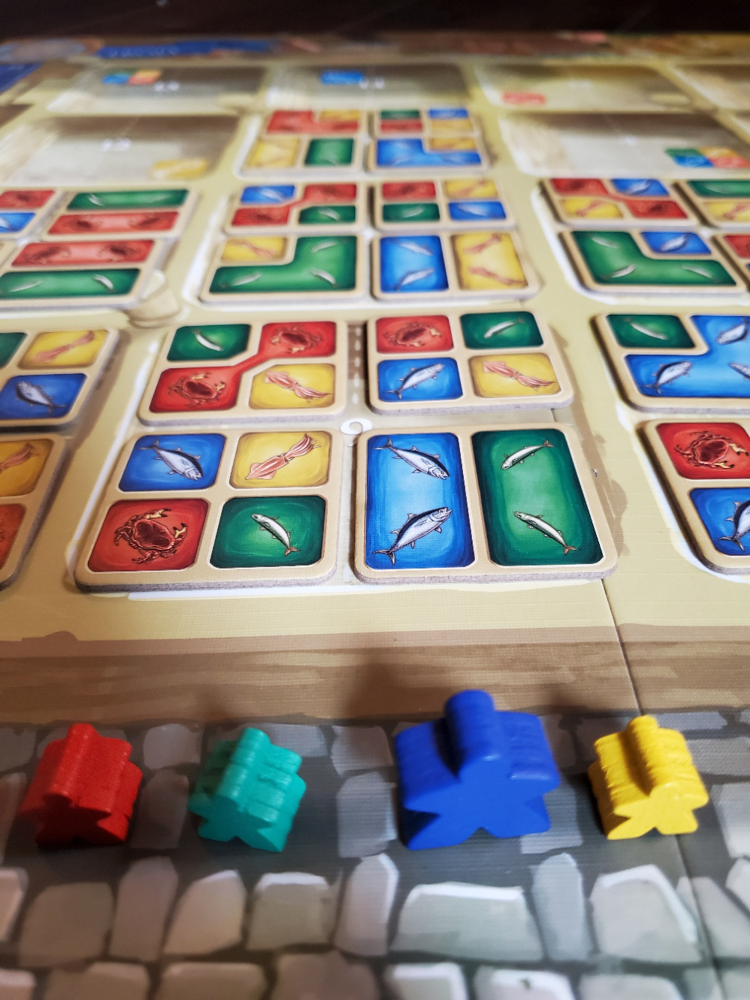
Along the way, each vat contains an icon somewhere inside that either indicates a particular color of fish or a combination of all four colors. If a player lays a tile on a single fish icon with the proper color aligned, they net two points. If the icon shows all four colors, any tile placement in that quadrant scores one point. These bonus points are a small fraction of the overall score, but they are enough to entice certain placement strategies.
Keeping the recipe spicy, once three of the four vats in a given row or column are complete, meeples may no longer be added. In other words, if players wait too long to stake their claims, they may end up a fish out of—sorry, too easy.
After sixteen rounds, players spend a few minutes wishing there was an app that scored Garum via an overhead picture. A handy player aid indicates the value of each meeple based on the number of icons aligned. It’s really not that difficult, but there are twenty-four meeples out there and a lot of icons to count.
Hunger Games: Baelo Claudia
The backside of the Garum board, labeled Baelo Claudia, offers a second layout for faster, crunchier play. There are still sixteen vats, but four of them are blocked, illustrated as full of the fermented good stuff, leaving only three vats in any row or column. Fittingly, the player hand is reduced to three tiles after removing a few specific tiles to even out the challenge. The backside of the player aid presents a more forgiving scoring system for the more compact board.
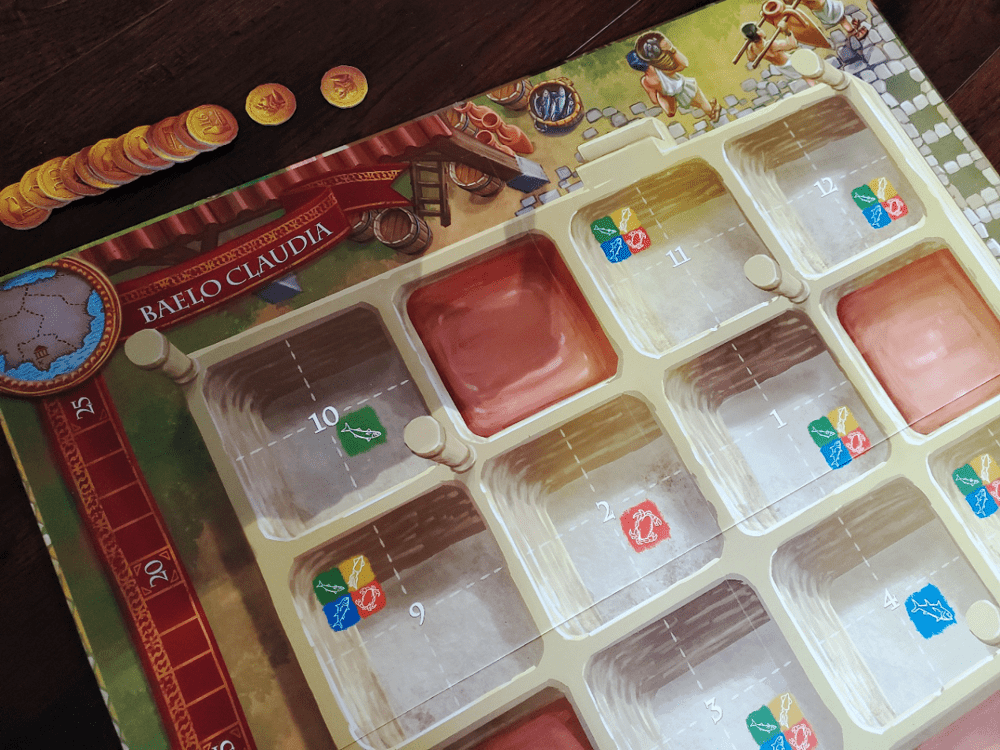
Adding an extra splash of flavor to the mix, the small two-sided Privileges token provides the response to any who would cry foul at the randomness of drawing both the aureus coins and the tiles. The token is single-use but with two options. The Neptune side allows a player to discard three of their starting tiles to redraw before the game begins. The Caesar side allows for a single peek into the stack to grab a specific tile at the opportune moment.
For those chanting for even more options, the Emperor variant grants the first player the right to strategically choose the cetarium for the round, while the Haruspex variant suggests revealing the aureus token order at the beginning of the game, allowing players to plan their tile usage accordingly.
Sea Bass and the Fellas…
Garum is clean, unlike the vision of ancient fish-fermenting vats that has danced in my imagination for the last couple months. I appreciate that Pythagoras makes room in every game to explore the history behind their unique settings, and Garum follows suit. I know more than I ever thought necessary about fish sauce.
It’s easy to teach—with an asterisk. The big picture is crystal clear from the beginning, but the nuances of laying tiles and meeples take the better part of a game to realize. Something in the math doesn’t add up without over-teaching; and while I believe in thoroughly teaching everyone how to play, I don’t want to tell them how to play once the game is in session.
In the Troia game, players have sixteen turns and only six meeples to place. It stands to reason that waiting a turn or two will pay off in selecting locations to control. However, as the various vats come out at random, it’s possible the game’s progression might push back against that brand of thinking. In the late game—especially the final four or even six turns—players cannot count on being able to claim a row thanks to the spicy three-fourths limiting rule I mentioned above. In this way, Garum naturally pushes players to speculate with their meeples and generate their points in the open air. Honestly, I celebrate it, but I definitely enjoyed it more beginning with the second game.
The three-fourths limitation is eliminated in the Baelo Claudia game. In fact, the layout of the board forces the restriction. As a result, I believe the BC board is a better way to introduce the game, even though the scoring is a bit tighter.
While I’m on the subject, the scoring is deceptive. You’re handed a player aid that inflates you with the hope of gaining eleven points for a small meeple if you can manage nine of your fish in a single row and a whopping twenty-two for the grande. Nine fish. In sixteen spaces. Once again, the math pushes back because you can only place four tiles in that row—eight total fish (assuming you place your best tiles together). You just can’t bank on nine, even though it’s likely someone will have to unwillingly help you somewhere along the way. Six or seven fish are far more likely, scoring two, four, or eight points. That’s a healthy reduction from eleven or twenty-two!
Believe it or not, all that I just said is one extended asterisk to how easy the game is to teach. These nuances will be obvious at some point during the first play. The only question is when, and as a caveat, to what effect. I’ve yet to find someone who was upset, but the bulb illuminates at a different point for everyone.
In the end, on the Troia side, players can push and exceed 50pts for a game. The Baelo Claudia side cuts that by a dozen or more in our experience. You can see the value of getting 22pts out of the grande meeple, but it can’t be at the expense of the rest of the board.
There’s a bit of nasty under the hood in this one (beyond that fishy smell). As the meeples make their way around the board, decisions increasingly hold the tension between helping me and whatever I do, don’t help Kerstynn…or Bryan…or anyone, for that matter. Players sit there, spinning tiles to make sure the icons are as entirely self-serving as possible. And yet, the whole experience is fairly relaxing. It’s nice to be able to wield a battle axe in peace.

There is nothing jaw-dropping in the physical production, but again, it’s clean. The board, tiles, and tokens are sturdy. The color scheme for the fish is bold and primary. They really pop off the subdued board so that scoring is easy to read. The first player marker, a two piece amphora (jug), doesn’t stand upright in our copy, but it’s really no big deal. We just pass one of the flat pieces around. I’m sure I’ll get around to fiddling with the notch to make it right. I remember Rossio gave me a similar vibe—nothing spectacular, but also nothing amiss.
I think the game I’m most reminded of when I play Garum is Topiary from Fever Games and Renegade. It must be the combination of laying a tile grid under the watchful eyes of surrounding meeples. I’ve not come across many with this approach, but I like it. There’s not much to set the world aflame, but there’s an interesting experience in the box.
There’s not much more to ask for in a puzzly game. Easy on the eyes. Easy to teach. A hint of depth. A touch of nasty. It’s the cleanest fish sauce game you’ll play this week. I guarantee it.


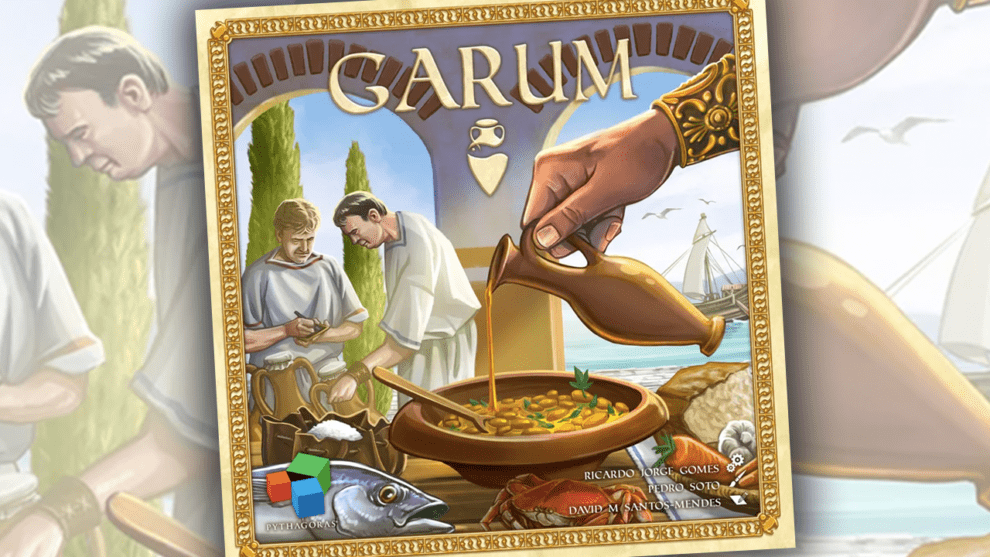

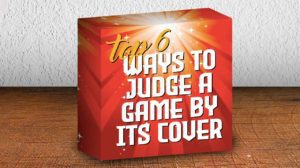







Add Comment